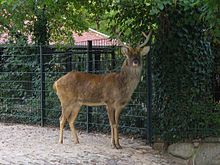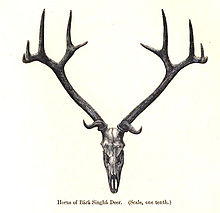Barasingha
| Barasingha[1] | |
|---|---|

| |
| Scientific classification | |
| Kingdom: | |
| Phylum: | |
| Class: | |
| Order: | |
| Family: | |
| Genus: | |
| Species: | R. duvaucelii
|
| Binomial name | |
| Rucervus duvaucelii (G. Cuvier, 1823)
| |

| |
| Historic range (yellow); relict populations: duvaucelii (red); branderi (green); ranjitsinhi (blue) | |
The barasingha (Rucervus duvaucelii syn. Cervus duvaucelii), also called swamp deer is a deer species currently found in isolated localities in northern and central India, and southwestern Nepal. It is extinct in Pakistan and Bangladesh.[2]
The specific name commemorates the French naturalist Alfred Duvaucel.
The most striking feature of a barasingha is its antlers, with 10 to 14 tines on a mature stag, though some have been known to have up to 20. The name is derived from this characteristic and means "12-tined or horned" in Hindi.[3] In Assamese, barasingha is called dolhorina; dol meaning swamp. In central India, it is called goinjak (stags) or gaoni (hinds).
Characteristics


The Barasingha is a fairly large deer species that may stand 119 to 135 cm (47 to 53 in) at the shoulder and 180 cm (71 in) in head-and-body length. Stags (male deer) are notably heavier, at 170 to 283 kg (375 to 624 lb), than does (female deer), at 130 to 145 kg (287 to 320 lb).[4][5] Average antlers may measure 75 cm (30 in) round the curve with a girth of 13 cm (5.1 in) at mid beam.[6] A record antler measured 104.1 cm (41.0 in) round the curve.[3]
Distribution and habitat

Barasinghas used to inhabit the basins of the Indus, Ganges and Brahmaputra Rivers, as well as central India as far as the Godavari River. Bones over a thousand years old have been found in the Langhanj site in Gujarat. Today, barasinghas have disappeared entirely from the western part of their range. In 1964, the total population in India was estimated at 3000 to 4000 individuals.[citation needed]
In the Terai, they mainly live in marshland. In central India, they live in grasslands in the proximity of forests.[3]
In northeastern India, the surviving animals are found in Assam.[7] The swamp deer's main concentration in Assam is in Kaziranga National Park with a few survivors in Manas National Park.[8][9][10] It is in all probability extinct in Arunachal Pradesh.[11]
Two geographic races were earlier recognized. The nominate R. d. duvauceli, which is swamp-dwelling, is found in the Terai of Uttar Pradesh, Assam and in the Sunderbans. This race has splayed hooves that help in moving on the soft ground and has a larger skull. The race R. d. branderi (named after A. A. Dunbar Brander) is found on hard ground in central India, chiefly in Madhya Pradesh.[3] The race in Assam was subsequently assigned to a new race R. d. ranjitsinhi after M. K. Ranjitsinh.[12] This race is considered the most threatened.
In central India, the barasingha disappeared from all but the Kanha National Park. Even here, from an estimated 3000 individuals in the early 1950s, within a decade less than 100 survived. The number reached an all-time low of 66 in 1970.[13]
Ecology and behaviour
In central India, the herds comprise on average about 8–20 individuals, with large herds of up to 60. There are twice as many females than males. During the rut they form large herds of adults. The breeding season lasts from September to April, and births occur after a gestation of 240–250 days in August to November. The peak is in September and October in Kanha National Park.[14] They give birth to single calves.
They are basically crepuscular. They are less nocturnal than the sambar deer. When alarmed, they give out shrill, baying alarm calls.[3]
Captive specimens live up to 23 years.
Threats
Hunting, poaching and, more important, diversion of the bulk of grassland to agriculture, are considered the main causes of their reduced numbers. Tall grass is not only their food, but also provides security for young fawns during the birthing season.
George Schaller wrote: "Most of these remnants have or soon will have reached the point of no return."[14] The warning, however, was heeded in time. Concerted efforts at saving this species from extinction were made and have now borne fruit. Today, their count has crossed the 500 mark.[citation needed]
Introduced populations
Along with Indian blackbuck, nilgai and many other exotic deer and antelope from Africa, swamp deer are also living wild on hunting ranches in Texas. They were brought to USA almost 100 years ago for sport hunting. Hunters for whom bagging a stag with huge antlers with as many points as possible is a novelty, pay about $4000 as trophy fees for hunting a swamp deer, 10% of which is supposed to go back to India to preserve it and its habitat in its true home range, where it is close to extinction. It is US Government policy now that 10% of trophy fees for hunting an exotic species found on hunting ranches in USA should be sent back for the preservation of that species and its original habitat.[citation needed]
Cultural references
Rudyard Kipling in The Second Jungle Book featured a barasingha in the chapter "The Miracle of Purun Bhagat" by the name of "barasingh". It befriends Purun Bhagat because the man rubs the stag's velvet off his horns. Purun Bhagat then gives the barasinga nights in the shrine at which he is staying, with his warm fire, along with a few fresh chestnuts every now and then. Later as pay, the stag warns Purun Bhagat and his town about how the mountain on which they live is crumbling.
Barasingha is the state animal of Indian state ofMadhya Pradesh[15]
References
- ^ Grubb, P. (2005). Wilson, D. E.; Reeder, D. M. (eds.). Mammal Species of the World: A Taxonomic and Geographic Reference (3rd ed.). Baltimore, MD: Johns Hopkins University Press. pp. 668–669. ISBN 0-8018-8221-4. OCLC 62265494.
- ^ a b Template:IUCN.
- ^ a b c d e Prater, S. H. (1948). The book of Indian animals. Oxford University Press. (10th ed.)
- ^ Ungulates. Oldwww.wii.gov.in. Retrieved on 2012-08-23.
- ^ Barasingha – Cervus duvaucelii : WAZA : World Association of Zoos and Aquariums. WAZA. Retrieved on 2012-08-23.
- ^ "Swamp Deer / Barasingha". wildlywise.com.
- ^ Choudhury, A. U. (1997). Checklist of the mammals of Assam. 2nd ed. Gibbon Books & Assam Science Technology & Environment Council, Guwahati, India. ISBN 81-900866-O-X
- ^ Choudhury, A.U. (2004). Kaziranga: Wildlife in Assam. Rupa & Co., New Delhi.
- ^ Choudhury, A. U. (1987). "Railway threat to Kaziranga" (PDF). Oryx. 21 (3): 160–163. doi:10.1017/S0030605300026892.
- ^ Choudhury, A. U. (1986). Manas Sanctuary threatened by extraneous factors. The Sentinel.
- ^ Choudhury, A. U. (2003). The mammals of Arunachal Pradesh. Regency Publications, New Delhi ISBN 8187498803.
- ^ Groves, C. (1983). "Geographic variation in the Barasingha or Swamp Deer (Cervus duvauceli)". Journal of the Bombay Natural History Society. 79: 620–629.
- ^ ''Animal Info – Barasinha''. Animalinfo.org. Retrieved on 2012-08-23.
- ^ a b Schaller, G.B. (1967). The Deer and the Tiger – A Study of Wildlife in India. University Chicago Press, Chicago, IL, USA.
- ^ http://www.pannatigerreserve.in/kids/state.htm
Further reading
- M. Acharya, M. Barad, S.Bhalani, P. Bilgi, M.Panchal, V.Shrimali, W. Solanki, D.M. Thumber. Kanha Chronicle, Centre for Environment Education, Ahmedabad in collaboration with the United States National Park Service.

